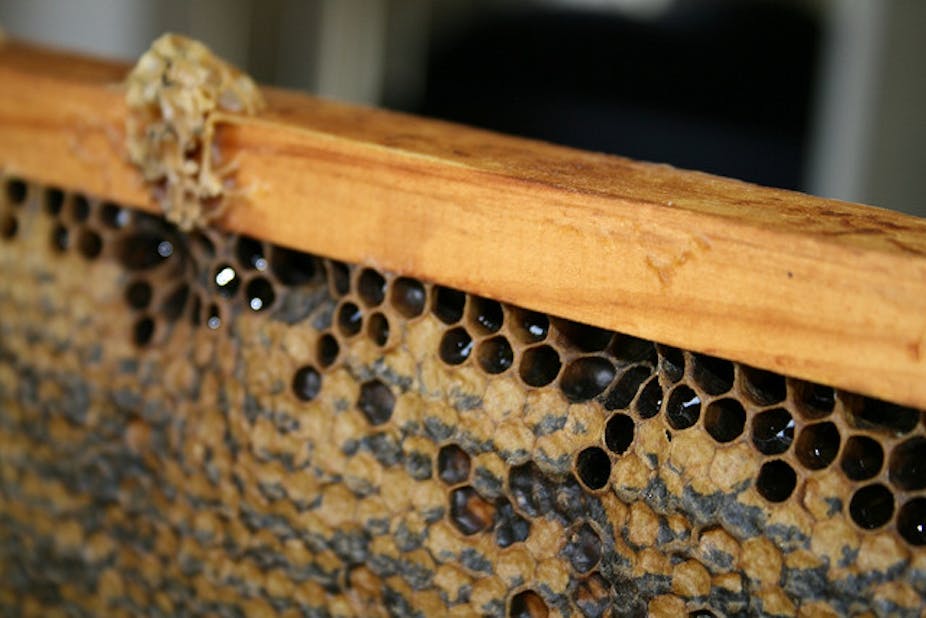Honey has been regarded as a delicious and natural sweetener for at least 4,000 years. As well as a food, ancient peoples also regarded honey as an ointment and its antibacterial properties are currently bringing excitement to some researchers.
Honey’s place as the main sweetener of food was displaced to a large extent when sugar was produced from sugar cane, and later from sugar beet (especially in Europe) and as a syrup from corn (in the United States).
As a food, Food Standards Australia New Zealand reports that 100 millilitres of honey contains 117.4 grams sugars, made up of 58.1 grams of fructose, 47.5 grams of glucose, 2.3 grams of sucrose and 9.6 grams of maltose. Vitamins are virtually absent and levels of protein and most minerals are insignificant.
Although honey appears to be a collection of sugars, it contains a range of unusual simple sugars as well as oligosaccharides (complex sugars), natural compounds known as phenols and an enzyme called glucose oxidase that can produce hydrogen peroxide and gluconic acid from glucose. These features have little nutritional relevance but may be important in the topical use of honey.
On the downside, honey can harbour the spores of the bacterium Clostridium botulinum (which causes botulism) and infant feeding guidelines recommend that babies under 12 months of age should not consume honey.
The newly-released Australian Dietary Guidelines (2013) advise us to limit foods and drinks containing added sugars. Although honey doesn’t rate a specific mention, it is considered an added sugar. But unless you sweeten foods extensively with honey at home, it can probably be ignored since per capita consumption of honey in Australia averages less than two grams a day.
Down the long list
Food companies recognise that honey may attract customers because it sounds healthier than sugar. If honey appears in the name of a product, the percentage must be included in the ingredient list on the food’s label. But don’t expect to find it near the top. Processed breakfast cereals that include honey usually contain between 2% and 6%, much less than their content of other sugars.
One popular “honey cereal” lists sugar, wheat, dextrose (a form of glucose), honey, vegetable oil, salt, caramel colour, soy lecithin, BHT (butylated hydroxytoluene, an industrially-produced antioxidant) and various vitamins and minerals. Honey is pipped in prominence by two other sugars.
Among products considered to be healthier, a “cluster” muesli with honey lists cereals (70%) [wholegrains (53%) (wheat, oats, wheat flour), corn, puffed wheat, wheat bran, rice], sugar, macadamia nuts (6%), corn maltodextrin (a starch), honey (2%), minerals (calcium, iron), sunflower oil, maize starch, barley malt extract, salt, flavours, then five vitamins.
In most yoghurts, ice creams and confectionery that feature honey, the quantities are again dwarfed by sugar.
Honey may cause technical problems in some processed foods, but the major reason for its low usage is its cost. Ordinary sugar (sucrose), dextrose and other sugars are much cheaper.
Indeed, honey provides a good example of why we should look at a food in its entirety rather than picking on the presence or absence of particular nutrients. Plenty of research shows that some varieties of honey have anti-inflammatory and antibacterial benefits that are unrelated to nutrients.
Manuka and other medicinal honeys
Manuka honey from bees that access certain varieties of Leptospermum (a plant from the myrtle family Myrtaceae), especially Leptospermum Scoparium (tea tree). It contains methylglyoxal, a phenolic compound with potent antibacterial properties.
Among its actions, manuka honey has the potential to act against the superbug methicillin-resistant Staphylococcus aureus (MRSA). This alone could make it a valuable addition to the medical armoury needed to combat potentially deadly infections.
Manuka honey also appears to have antibacterial factors other than methylglyoxal. Several groups are researching its properties, including at the University of Amsterdam, University of Technology, Sydney, and at the University of Thassaly in Greece where Greek and Cypriot honeys are showing some of same benefits attributed to manuka honey.
Researchers at the University of Ljubljana, Slovenia are also testing their honeys, as are others in Malaysia, Canada and South Africa.
More studies are obviously needed, but with increasing levels of antibiotic resistance causing problems throughout the world, treatment of chronic wounds and infections with something as simple as a particular type of honey has profound implications for the future.
Sadly, there’s little quality research to suggest major benefits from eating honey. It does contain polyphenols (although their value in the human diet is unclear), but to get sufficient quantities, you’d need to consume a lot of honey. For most of us, that’s not good news for the waistline. Honey is also a potential dental hazard. Enjoy it in small quantities.

